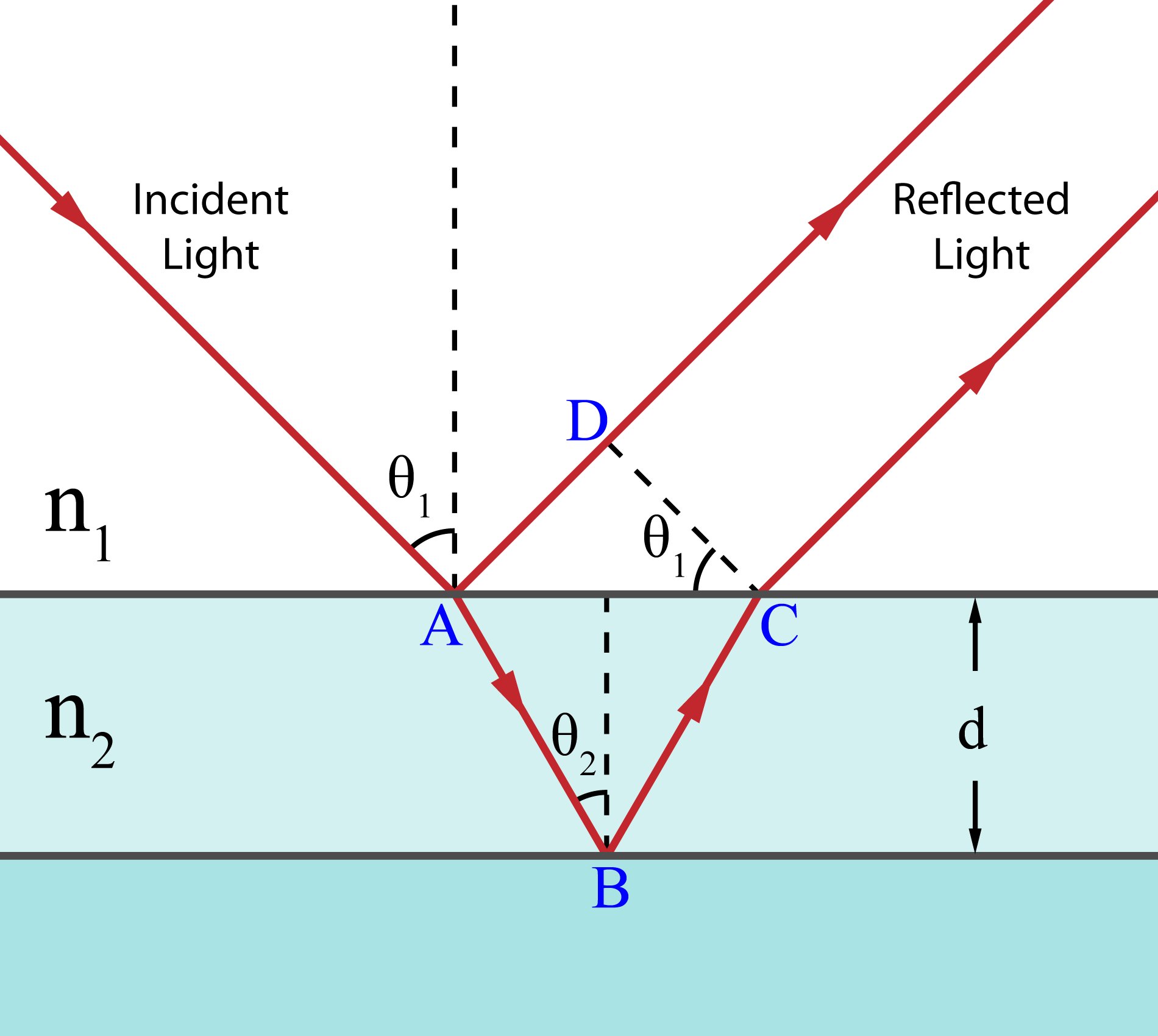Consider a ray of light incident on a thin film of thickness #d# (in the sub-nanometer to micron range) as in the figure below.
We are required to find minimum thickness of a thin film required for constructive interference in the reflected light.
 )
)
The ray travels from a medium of refractive index #n_1# to a medium of refractive index #n_2.# As light strikes the surface of thin film at #A# at the upper surface, part of it is transmitted and remaining reflected. Part of light which is transmitted reaches the bottom surface and hits it at #B#, it may once again be transmitted and/or reflected depending on the refractive index of the medium below the thin film.
The occurrence of constructive or destructive interference between the two reflected light waves depends on their phase difference. This difference depends on
1. the thickness of the film layer,
2. the refractive index of the film, and
3. the angle of incidence of the original wave on the film.
Additionally, a phase shift of #180^@# or #pi# radians occurs at the boundary depending on the refractive indices of the materials on either side of the interface. This may happen both at points #A and B#. This phase shift occurs at #A# if #n_1 < n_2#.
Armed with information we know that to get constructive interference, the two reflected rays have to be shifted by an integral multiple of wavelength #lambda#.
For minimum thickness of thin film, it must be #=lambda#. Therefore, we must choose the three media so that phase of #180^@# or #pi# radians occurs at #A#, and remaining #180^@# or #pi# radians by distance traveled by the transmitted ray down and up through the thin film. No phase shift at #B#
(This has been taken care of by choosing the media in the figure above. Light bends towards the normal when traveling from a rarer to denser medium, #n_1 < n_2#).
It implies that, the thin film must introduce integral multiple of #1//4# wavelength phase one way. For minimum thickness we must have the phase as #lambda//4#
Also the minimum #d# the incident ray must strike at the interface at #A# with #theta_1=0#. The transmitted part of the ray travels #2d# (down and up) and meet the reflected part of ray at #A# to be in phase.
We know that wavelength in vacuum is related to wavelength in a medium of refractive index #n# as
#lambda_"film"=lambda_"vacuum"/n#, inserting given values
#lambda_"film"=600/1.5=400nm#,
Equating with condition for constructive interference and solving for #d#
#d=400/4#
#d=100nm#
.-.-.-.-.-.-.-.-.-.-.-.-.-.--.-.-.-.-.--.-.
Detailed derivation
From the figure,
Path traveled by reflected ray at #A=AD#, in medium #n_1#
Path traveled by reflected ray at #B=AB+BC#, in medium #n_2#
Path difference#=n_2(AB+BC)-n_1AD# .....(1)
Now #AB=BC=d/(cos theta_2)# .....(2)
Also #AC=2d.tan theta_2#
and #(AD)/(AC)=sin theta _1#
#:.AD=2d.tan theta_2 .sin theta_1#
Changing the expression in terms of #theta_2#, by using Snell's law #n_1\sin\theta_1=n_2\sin\theta_2#
#=>sintheta_1=n_2/n_1\sin\theta_2#, inserting in for #AD#, we get
#AD=2d.tan theta_2 .n_2/n_1\sin\theta_2# .....(3)
Substituting from (2) and (3) in (1)
Path difference#=n_2 (2d)/(cos theta_2)-n_1. 2dtan theta_2 .n_2/n_1\sin\theta_2#
# = n_2\frac{2d}{\cos\theta_2} - 2d\tan\theta_2.n_2\sin\theta_2#
#= 2dn_2(\frac{1-\sin^2\theta_2}{\cos\theta_2})#
#= 2dn_2\cos\theta_2 #
For constructive interference this Path difference should be equal to integral multiple of wavelength, #nlambda#.
For minimum thickness of a thin film this must equal #lambda#. Equating the two we obtain
#2dn_2\cos\theta_2=lambda#
Additional path difference introduced by reflection at #A=lambda/2#
Condition changes and hence net path difference required #=2dn_2\cos\theta_2= lambda/2#
Solving for #d#
#d=1/4lambda/(n_2\cos\theta_2)#
Maximum value of #costheta=1# which gives minimum value of #d#
Hence #d_"min"=lambda/(4n_2)#
Inserting given values
#d_"min"= 600/(4xx1.5)#
#=100nm#
 )
) 